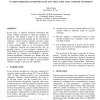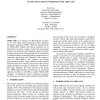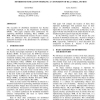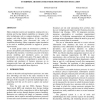WSC
1998
14 years 27 days ago
1998
In this paper, an efficient simulation environment that utilizes compiler techniques to speed up simulation is presented. The method is based on the utilization of flexible, proce...
WSC
1998
14 years 27 days ago
1998
Globalisation and competitive pressure urge many organisations to radically change business processes. Although this approach can provide significant benefits such as reducing cos...
WSC
1998
14 years 27 days ago
1998
MODSIM II is an object-oriented discrete event simulation language featuring extensive run-time libraries, graphical user interface and results presentation tools, database access...
WSC
1998
14 years 27 days ago
1998
The RESTART method is a widely applicable simulation technique for the estimation of rare event probabilities. The method is based on the idea to restart the simulation in certain...
WSC
1998
14 years 27 days ago
1998
VHDL-AMS is an Analog and Mixed-Signal extension to the Very High Speed Integrated Circuit Hardware Description Language (VHDL). With the standardization of VHDL-AMS, capable and ...
WSC
1998
14 years 27 days ago
1998
The execution of distributed simulations has become increasingly important to the Department of Defense (DOD). This paper compares three architectures for supporting distributed c...
WSC
1998
14 years 27 days ago
1998
This paper presents Timed Petri Nets (TPN) as an analytical approach for verification of computerized queueing network simulation models at steady state. It introduces a generic a...
WSC
1998
14 years 27 days ago
1998
Many simulation systems are standalone, running only on a desktop and having limited capabilities to integrate with other technologies such as company databases, workflow engines,...
MASCOTS
2000
14 years 27 days ago
2000
The memory resources required by network simulations can grow quadratically with size of the simulated network. In simulations that use routing tables at each node to perform perh...
ESM
2000
14 years 28 days ago
2000
The classical method of evaluation of simulations surely is the batch means method, see e.g. [Bratley et al. 1987], giving confidence intervals to express the precision of the sim...




